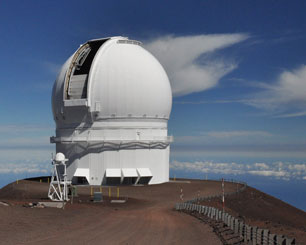
The Île-de-France Region has announced that it will provide financial support to the francilian teams which will participate in the SPIRou project (SpectroPolarimètre InfraRouge - infra-red polarimetric spectrometer). The CFHT has confirmed that it will contribute financially to the project, , which involves a large international consortium of universities and research laboratories. Construction will start in 2014 ; first light at the CFHT is foreseen for 2017. It will lead to the discovery of habitable exoEarths, and to study the birth of stars and planets.
SPIRou is an international project led by a team from the Institut de Recherche en Astrophysique et Planétologie (IRAP - Institute for research in astrophysics and planetology) in Toulouse, in which are participating many units of the Paris Observatory:the LESIA4, the IMCCE4, the LERMA4, and the LUTh4, with the support of the Île-de-France region.
ExoEarths and the birt of stars and planets
This instrument will serve to detect habitable exoEarths around red dwarf stars, as well as to study the birth of stars and planets.
How are stars and planets born ? How does the magnetic field affect these processes ? Is the Earth, which has a considerable quantity of surface water, unique ? Does our galaxy have other similar planets ? Universal questions which are the preoccupation in particular of stellar and planetary astrophysicists, for whom SPIRou should furnis fresh answers during the coming decade.

A technological challenge
To be able to detect and study these objects, SPIRou will be made up of a spectro-polarimeter2 combined with a high precision velocimeter optimised for the detection of exoplanets using the radial velocity method3.
SPIRou is a spectropolarimeter which which splits up stellar light into its colours and basic frequencies ; it is also a very accurate velocimeter. Much as a roadside radar which "flashes" the observed star, not so much for going too fast, but rather to detect the tiny regular and quasi-periodic changes in velocity whch reveal the presence of a planet orbiting the star. SPIRou willl thus lead the hunt for sister planets of the Earth in planetary systems arund red dwarf stars in the neighbourhood of the Sun.
The atmospheres of these sister planets could then be scrutinized using the James Webb Space Telescope6 the next space telescope, to look for water and other biological molecules associated with the presence of life. SPIRou will also be able to penetrate the mystery of how stars and planets are born, by observing for the first time the magnetic fields of proto-stars which are just several hunderd thousand years old.
From the technological point of view, SPIRou presents a major challenge. It must operate in the infra-red, in order to be able to observe in an optimal way the cold stars which constitute the red dwarfs. To do this, the heart of the instrument, the spectrometer, must be within a cryostat cooled to the temperature of liquid nitrogen (-196°C) in order to protect the instrument from the the universal thermal infra-red radiation which would otherwise drown the weak stellar radiation which we are trying to decode. Moreover, in order to detect the nonometer shifts of the specta which reveal the presence of habitable Earths, the cryostat must have a thermal stability of several thousandths of a degree Celsius.
Integration of the instrument is foreseeen for 2016 at Toulouse - at the Toulouse III Paul Sabatier University, at the Observatoire Midi-Pyrénées (OMP), at the Institut de Recherche en Astrophysique et Planétologie (IRAP - Institute for Research in Astrophysics and Planetology) ; first light is foressen for 2017 at the CFHT.
Leading Rôle of France
SPIRou is governed by a consortium of seven countries (France, Canada, Switzerland, Taiwan, Portugal, Brazil, USA) and more than 10 laboratories.
France, with four laboratories participating at the technical level (IRAP, IPAG, OHP/LAM, LESIA), is plaing a major rôlein the design and construction of SPIRou, taking in particular responsibility for the construction of the Cassegrain unit and fibre optic link, as well as the final integration and testing of the complete instrument.
SPIRou has been assigned as a priority astrophysics project of the National Center for Scientific Research (CNRS), and the CFHT has just confirmed its financial participation, to which is contributing a large international consortium of universities and resarch laboratories4.
Budget
The budget of this international project is a measure of the scientific challenge ; it is 10 M€ (including the construction costs of 4 M€). The French consortium, which consists of many universities, observatories and laboratories under the double trusteeship of the CNRS and the Ministry for Higher Education and Research, in particular based at Toulous, Grenoble, Marseille and the Île-de-France, furnish the major part of the finance, and are the major actors in the realization of the project ; the Île-de-France region is contributing at the level of 600 k€.
The francilian team
The francilian part of the SPIRou team is important, and consists of about twenty scientists from the eight laboratories which are participating in the DIM ACAV ; the scientific objectives targetted by the project are exoplanets, stellar and planetary formation, atmospheres, magnetism and habitability.
Partnership
SPIRou has has joined forces with a faithful ally for the dissemination of its future discoveries among the younger generation : it has created a partnership with the Journal de Spirou !
